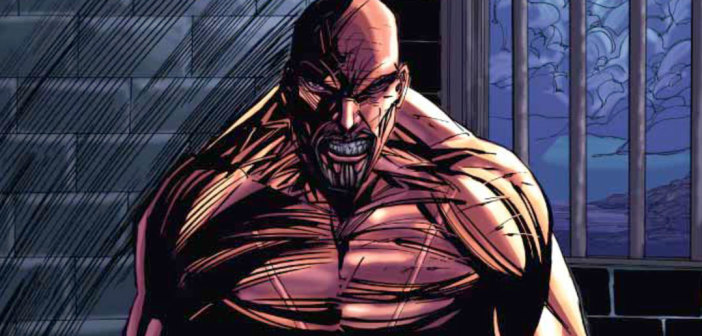Ronin Studio’s Omnitarium is a comic book rich with atmospherics, opening in the Sixteenth Century and then shifting its timeframe to the Victorian era of the Seventeenth Century. Writer Jamie Gambell and artist J.C. Grande are both confidant in the story they want to tell, employing a steady narrative and strong visual techniques that have constructed a solid foundation for future issues to come.
Omnitarium tells the story of the murderous sorcerer, Lucius Moonheart, and the hardened inquisitor who captured him, Blutstein (which, if my high school German still serves any purpose, translates exactly into “Bloodstone”). The book opens in the year 1772 on Northern Ireland’s Rathlin Island. The day of Moonheart’s execution has arrived, but it doesn’t go smoothly because of the warlock’s irksome ability to survive a four-hour hanging. A duel between Moonheart and Blutstein ensues, a duel I could have lived without; the battled emphasized for me the tired cliché of villains resisting death time and again, drawing far too much attention to itself. Nonetheless, Blutstein puts Moonheart down personally with the blade of a sword. Unless…
Leap forward in time to the London of 1869, where Mr. Miller is introduced as the master of Pentansly Gaol, a correctional facility that employs the prisoners it incarcerates as laborers. During this time Miller is visited by three guests: Mr. Jameson, Mr. White, and White’s niece, and during their visit Miller gives them a full tour of the property. I’m not sure what Gambell is up to, but on page 21 Jameson makes an effete comment: “You do offer quite a life for some of these people, here, much better than they would expect outside these walls; what is there to attract these fine people back into the outside world, once their service is complete?” Below this question is a large shot of a sullen prisoner, a man whose experience at Pentansly Gaol is clearly anything but “quite a life.” Whatever Gambell’s message is, the page is tense with passive bourgeois/proletariat aggression.
By the end of the first issue, the story’s occult themes take center stage once again; a doctor named Livingsly is seen performing autopsies on dead inmates, all of whom have deformed organs riddled with abnormal growths. And to complete the story, the final page showcases a dark and looming prison hall where Pentansly Gaol’s psychotic inmates are locked up. The corridors are filled with screams proclaiming that “he’s inside me.”
The second half of Omnitarium worked for me much more than the first, which relied on a common formula of chaotic witch trials and hardboiled personages of heroes and villains. But the 1869 plotline works against the interesting British backdrop of the Victorian era, adding a touch of mystery to the story. This direction follows in the footsteps of classics like Alan Moore’s From Hell and The League of Extraordinary Gentlemen, as well as some of the tales that appeared in Neil Gaiman’s The Sandman series. No, Omnitarium is not on the level of those titles by any means, but to be fair, there are very few comic books that are. But it evokes a similar feeling, and that’s to Gambell’s credit.
The same goes for J.C. Grande’s artwork. In the 1772 portion, the character illustrations looked more like rough sketches than they did finished images. This is especially true for Blutstein, who appeared to be a rough outline of Dr. Doom awaiting approval from Brian Bendis instead of a completed character. But for whatever reason, the Victorian backdrop of 1869 seems to suit Grande’s talents well; the stuffy and stagnant atmosphere of the period is solidly captured in the artist’s sharp black-and-white images, oftentimes taking on a stark chiaroscuro presence on the page. Grande is especially skilled at illustrating settings and backgrounds: Pentansly Gaol’s courtyard is a rich marvel to drink up, which the bleak prison halls are harsh and spooky.
I don’t know what kind of relationship Gambell and Grande share, but judging by Omnitarium, they work well together and could very well be onto something with this book. I didn’t need anymore indication after seeing page 17, a smooth panel layout that reinforces the definition of “sequential art” attributed to comics. Nothing of great importance unfolds on the page story-wise; it simply illustrates two characters walking down a flight of stairs towards a front door. But the sequential layout is superb, and that’s what comics are all about. If this is where future issues of Omnitarium are heading, then I’m more than interested in following along.
This comic book review originally appeared on Broken Frontier on 18 November 2009.




